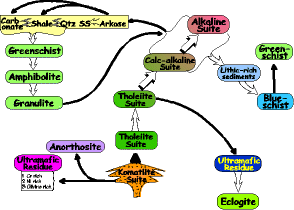 Stage I Stable Continental Craton  The cycle which began in Stage A now comes to an end. The original continental craton of Stage A which was rifted into two pieces in Stage C is now back together, and stabilized once more. Note, however, that this new continent is quite complex compared with the Stage A craton, and that the basement rocks exposed at the surface are very diversified. In the enlarged and detailed drawing you can see that in addition to the original Westcontinent and Eastcontinent blocks there is a volcanic arc trapped between then, and there are now two foreland basin clastic wedges (probably filled with quite different sediments since one was eroded from a volcanic arc and one from a cordilleran mountain). There are two suture zones of melange and a host of different igneous and metamorphic rocks. Nonetheless, when everything is finally weathered to completion and the continent is eroded to a peneplain the simple ideal model for sedimentary rocks will be in force and this continental craton will be dominated by a veneer of quartz sand (QFL diagram, yellow field) and limestones. Shales may also be present at first, but with enough time, these are eventually washed off the continental edge into the surrounding oceans. In Stage A we began with an ideal continent, assuming it was homogeneous in structure and composition. In light of the Wilson cycle history you have just reviewed, it should be clear that the original continent was not homogeneous. Over, and over, and over, since the first crust solidified, the processes of subduction have been making new continental crust. Collisions have been welding them together, and rifting has been fragmenting them. It is the work of geologists to read great events in the rocks of the earth's crust, but it is also something like a flea trying to understand the great dog it is living on. Many geologists spend their time walking the earth, looking at the rocks at their feet, trying to understand the ancient meanings they have. Endlessly fascinating, endlessly frustrating, and immensely satisfying when we glimpse a little of the greatness of it.  The Wilson Cycle is a relatively simple model of how the earth works and evolves. But is there an even simpler or more theoretically abstract model of how the earth works? A single model that incorporates everything in the Wilson Cycle?
The Wilson Cycle is a relatively simple model of how the earth works and evolves. But is there an even simpler or more theoretically abstract model of how the earth works? A single model that incorporates everything in the Wilson Cycle?There is, and it is the Tectonic Rock Cycle. Click on the drawing for an enlarged version, or click this Tectonic Rock Cycle to go to the description of the model. The Stage I enlarged drawing contains evidence of all the events and processes occurring during the Wilson Cycle. The question is, can you reconstruct them? Can you go through the final cross section and identify specific rock types, or specific tectonic regimes, or specific tectonic stages in the Wilson Cycle? » Identify the stage of the Wilson cycle they formed in, or . . . » Identify what tectonic regime they represent; e.g. DCM, volcanic arc, axial rift. etc. (All the letters are hot and will take you to an answer) » Identify the rock type (igneous, sedimentary, metamorphic) and specific rock (e.g. greenschist, arkose, etc.) that would reasonably be found at each location. » Describe the processes by which each rock formed. If the rock is altered from a parent identify the parent. » Identify the tectonic regime and/or Wilson Cycle stage each rock formed in. |